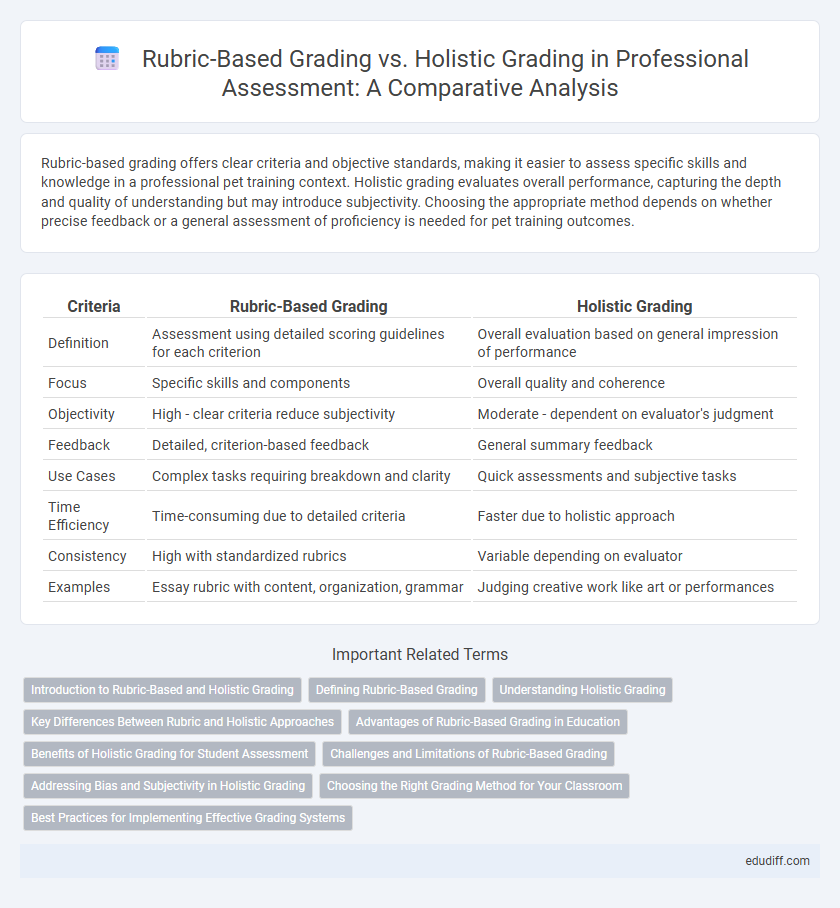Rubric-based grading offers clear criteria and objective standards, making it easier to assess specific skills and knowledge in a professional pet training context. Holistic grading evaluates overall performance, capturing the depth and quality of understanding but may introduce subjectivity. Choosing the appropriate method depends on whether precise feedback or a general assessment of proficiency is needed for pet training outcomes.
Table of Comparison
| Criteria | Rubric-Based Grading | Holistic Grading |
|---|---|---|
| Definition | Assessment using detailed scoring guidelines for each criterion | Overall evaluation based on general impression of performance |
| Focus | Specific skills and components | Overall quality and coherence |
| Objectivity | High - clear criteria reduce subjectivity | Moderate - dependent on evaluator's judgment |
| Feedback | Detailed, criterion-based feedback | General summary feedback |
| Use Cases | Complex tasks requiring breakdown and clarity | Quick assessments and subjective tasks |
| Time Efficiency | Time-consuming due to detailed criteria | Faster due to holistic approach |
| Consistency | High with standardized rubrics | Variable depending on evaluator |
| Examples | Essay rubric with content, organization, grammar | Judging creative work like art or performances |
Introduction to Rubric-Based and Holistic Grading
Rubric-based grading utilizes detailed criteria and standardized scoring to evaluate student performance, enhancing objectivity and clarity in assessment. Holistic grading assesses overall quality by considering a student's work as a whole, allowing evaluators to integrate multiple aspects into a single judgment. Both methods serve distinct purposes in professional education settings, balancing precision with comprehensive evaluation.
Defining Rubric-Based Grading
Rubric-based grading is an assessment method that uses a detailed scoring guide to evaluate specific criteria within student work, ensuring consistent and transparent feedback. This method breaks down assignments into measurable components such as clarity, accuracy, and creativity, with predefined performance levels for each criterion. By providing clear expectations, rubric-based grading helps instructors maintain objectivity and supports students in understanding areas for improvement.
Understanding Holistic Grading
Holistic grading evaluates student work as a whole, emphasizing overall quality and coherence rather than isolated components, making it effective for assessing complex assignments like essays or projects. This method relies heavily on the grader's expert judgment and is advantageous for capturing nuanced understanding and creativity in student responses. Holistic grading can enhance efficiency by reducing the time spent on detailed scoring criteria, while providing meaningful feedback on general performance.
Key Differences Between Rubric and Holistic Approaches
Rubric-based grading evaluates student performance using specific criteria and detailed scoring guides, promoting transparency and consistency across assessments. Holistic grading, conversely, assesses overall work quality without predefined categories, offering flexibility but potentially introducing subjectivity. Key differences include the structured analysis and targeted feedback provided by rubrics versus the broad, integrative judgment characteristic of holistic evaluation.
Advantages of Rubric-Based Grading in Education
Rubric-based grading enhances transparency and consistency by providing clear criteria aligned with learning objectives, which helps students understand expectations and areas for improvement. It facilitates objective assessment across diverse assignments, reducing bias and promoting fairness in evaluation. This method also supports targeted feedback, enabling educators to pinpoint specific strengths and weaknesses, thereby improving instructional effectiveness.
Benefits of Holistic Grading for Student Assessment
Holistic grading streamlines the evaluation process by assessing overall student performance, which encourages deeper understanding and critical thinking rather than fragmented skills assessment. It fosters creativity and flexibility, allowing educators to recognize unique strengths and diverse approaches within student work. This method supports a more authentic representation of student learning, promoting motivation and engagement through personalized feedback.
Challenges and Limitations of Rubric-Based Grading
Rubric-based grading often faces challenges such as rigid criteria that may not capture the full complexity of creative or critical thinking skills, leading to potential oversimplification of student performance. It can also impose time-consuming demands on educators to design detailed rubrics and consistently apply them, which may limit flexibility in assessment. Moreover, rubric-based grading risks subjective interpretation of criteria, potentially reducing inter-rater reliability despite its structured framework.
Addressing Bias and Subjectivity in Holistic Grading
Rubric-based grading minimizes bias and subjectivity by providing clear, predefined criteria that ensure consistent evaluation across different assessors. Holistic grading, while more flexible, often suffers from evaluator bias due to its reliance on overall impressions without standardized metrics. Implementing structured rubrics in holistic grading frameworks can improve fairness and reliability by aligning subjective judgments with explicit performance indicators.
Choosing the Right Grading Method for Your Classroom
Rubric-based grading offers clear criteria and objectivity, helping educators provide specific feedback aligned with learning objectives, which enhances transparency in assessment. Holistic grading evaluates overall performance and is efficient for subjective assignments but may lack detailed insights for individual skill development. Selecting the appropriate grading method depends on the nature of the assignment, desired feedback specificity, and the instructional goals within your classroom setting.
Best Practices for Implementing Effective Grading Systems
Rubric-based grading enhances transparency and consistency by clearly defining assessment criteria tied to specific learning outcomes, enabling precise feedback and measurable student performance tracking. Holistic grading, while efficient for evaluating overall quality, benefits from tailored guidelines to ensure reliability and reduce subjectivity among different evaluators. Combining both practices through well-structured rubrics and standardization protocols promotes balanced, fair, and comprehensive grading systems in professional educational settings.
Rubric-Based Grading vs Holistic Grading Infographic

 edudiff.com
edudiff.com